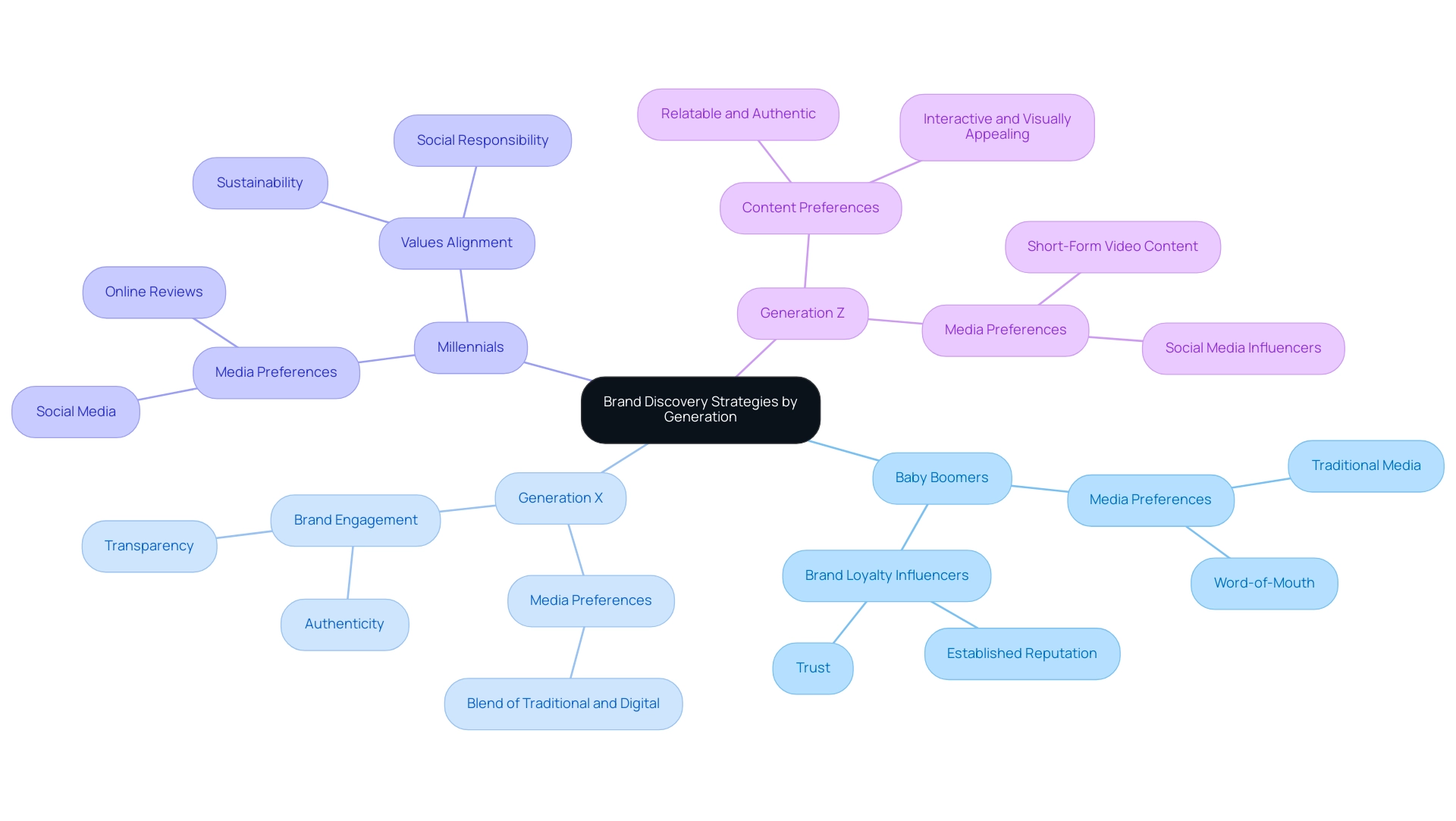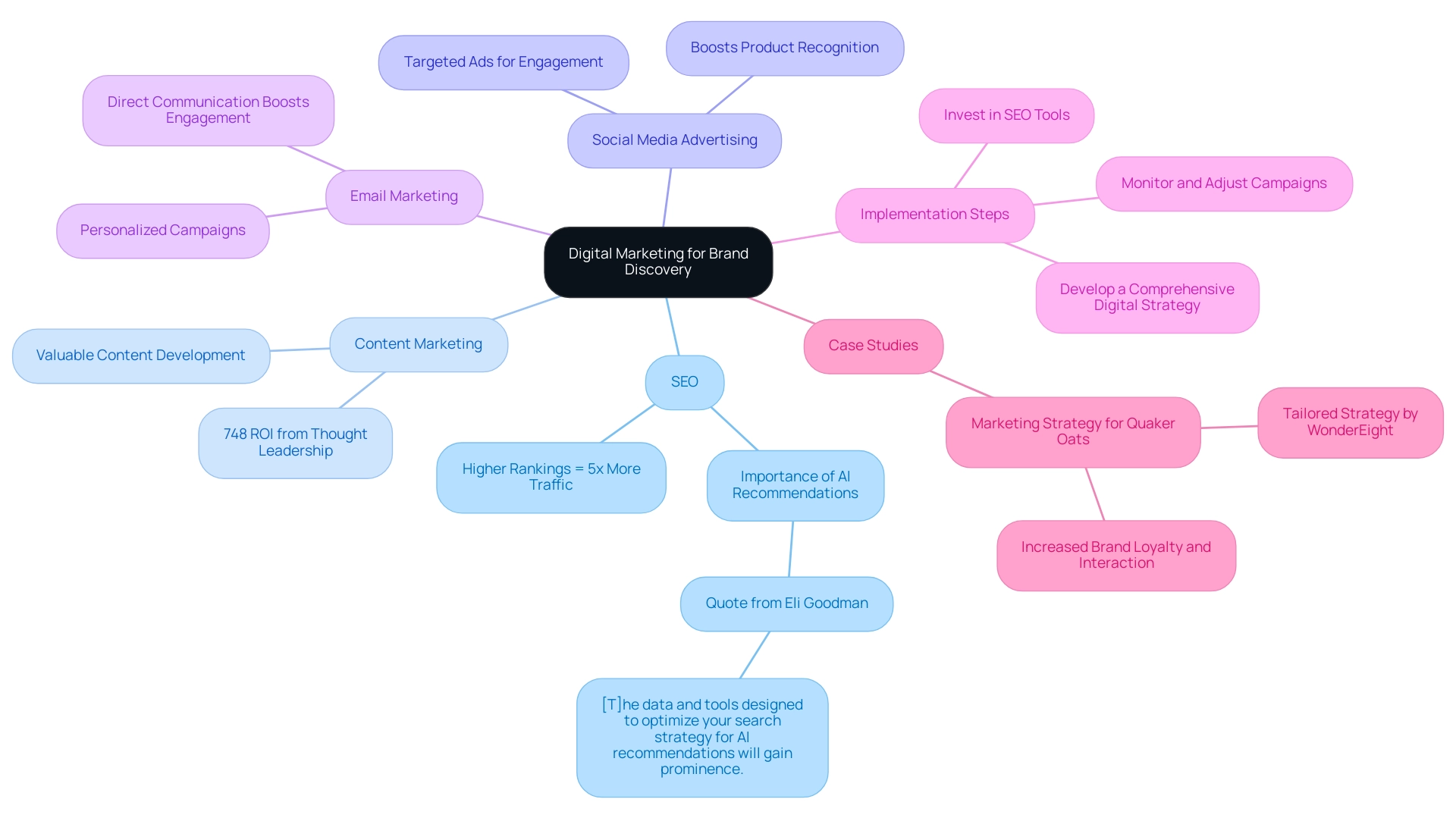Digital Branding Strategies
How to Discover New Brands: A Step-by-Step Guide for Brand Managers
Overview
The article titled “How to Discover New Brands: A Step-by-Step Guide for Brand Managers” outlines essential strategies that brand managers can implement to enhance brand discovery among consumers. It underscores the significance of:
- Understanding consumer behavior
- Leveraging digital marketing channels
- Customizing approaches to meet the diverse preferences of different generations
This tailored engagement is crucial for effectively connecting with potential customers and fostering enduring brand loyalty.
Introduction
In a marketplace overflowing with choices, the journey of brand discovery is paramount for consumer engagement. This intricate process—encompassing awareness, consideration, and preference—shapes how potential customers perceive and connect with brands. For brand managers, grasping the dynamics of this journey is essential for crafting strategies that resonate with their target audiences.
As consumers increasingly seek brands that align with their values, the ability to navigate the stages of brand discovery effectively becomes a game-changer. This article explores actionable insights and innovative strategies that empower brands to enhance visibility and foster lasting connections in an ever-evolving digital landscape.
Understanding Brand Discovery: The Key to Consumer Engagement
Product discovery represents a vital journey through which individuals become aware of and explore new brands, significantly shaping their perceptions and choices. For product managers, grasping the intricacies of this process is essential for fostering customer engagement. The stages of identity discovery—awareness, consideration, and preference—provide a framework for crafting effective strategies that resonate with target audiences.
- Research Consumer Behavior: It is imperative to delve into how consumers typically discover companies within your industry. In 2023, a striking 82% of potential candidates considered a company’s reputation before applying for a job, underscoring the necessity of a robust presence. Utilizing WonderEight’s digital audits can assist in identifying gaps in your online reputation and enhance visibility.
- Identify Key Touchpoints: Pinpointing the channels where consumers are most likely to encounter your business is crucial. With 67% of respondents considering event sustainability when organizing occasions, companies that showcase a commitment to social responsibility can significantly elevate their visibility and appeal. WonderEight’s integrated marketing solutions, including social media planning and event activations, can effectively position your company in front of the right audience.
- Assess Brand Image: Employing surveys or focus groups to gauge how individuals perceive your label during the discovery phase is vital. Understanding these perceptions can inform your branding initiatives and tailor your messaging accordingly. WonderEight’s expertise in CRM planning and execution can streamline this process, ensuring that your outreach is both focused and impactful.
Recent trends indicate that individuals are increasingly drawn to companies that align with their values, necessitating marketing managers to adapt their strategies accordingly. For instance, the extensive campaign created by WonderEight for Quaker Oats effectively engaged the target audience, resulting in heightened awareness and loyalty among customers. This case analysis illustrates how a well-executed identity exploration approach, supported by WonderEight’s diverse client portfolio, can yield tangible results.
By scrutinizing buyer behavior and preferences, identity managers can refine their methods to enhance visibility and attract potential clients. The influence of label discovery on consumer purchasing decisions is profound, shaping not only initial awareness of new brands but also fostering long-term loyalty and engagement. To further elevate your discovery strategies, consider exploring WonderEight’s comprehensive services, including SEO consultancy and website/app design, to ensure your identity stands out in a competitive landscape.

Channels of Brand Discovery: Where Consumers Look for New Brands
Consumers discover new brands through a diverse array of channels, each presenting distinct opportunities for engagement and visibility. The most prominent channels include:
- Social Media: Platforms such as Instagram, TikTok, and Facebook have become essential for brand discovery, particularly among younger audiences. In fact, social media advertising is anticipated to hit $256.5 billion worldwide by 2025, underscoring its significance in promotional strategies. Moreover, influencer marketing can yield up to 18 times the ROI of traditional advertising, establishing it as a formidable tool for managers. Search engines like Google remain the leading resource for individuals seeking products and labels, with a substantial proportion of users relying on them to discover new brands.
- Online Marketplaces: Websites like Amazon and eBay serve as crucial touchpoints for consumers, facilitating product discovery through listings and reviews.
- Traditional Media: Despite the rise of digital channels, television and print advertising continue to play a vital role in product discovery, particularly among specific demographic groups.
Dr. Dave Chaffey, a recognized digital strategist, emphasizes the importance of leveraging various channels for effective discovery, stating, “Understanding the landscape of marketing channels is crucial for companies aiming to connect with their audience.”
Steps to Leverage Discovery Channels:
- Analyze Channel Performance: Utilize analytics tools to evaluate which channels generate the most traffic and engagement for your business.
- Tailor Content for Each Channel: Create platform-specific content that resonates with the distinct audience of each channel, enhancing engagement and recall.
- Engage with Influencers: Collaborate with influencers who can effectively introduce your product to their followers, significantly boosting visibility and credibility.
As social media continues to evolve, understanding its influence on product discovery is crucial. Current trends indicate that posting frequency varies by platform; for instance, a single update may yield better results on Facebook due to its declining organic reach, while higher frequencies are more effective on LinkedIn and Twitter. This nuanced approach to social media can enhance visibility and foster deeper connections with potential customers.
Moreover, the trend of ad-supported SVOD tiers illustrates how companies are adapting to changing consumer behaviors. By introducing ad-supported options, companies can lower subscription costs while generating revenue from advertisers, showcasing a strategic shift in how they engage with their audience.
Tailoring Brand Discovery Strategies for Different Generations
Different generations exhibit distinct behaviors and preferences regarding product discovery, which is crucial for effective marketing strategies. Understanding these nuances can significantly enhance engagement and customer loyalty towards new brands. Here’s a breakdown of how each generation approaches brand discovery:
-
Baby Boomers: This generation typically relies on traditional media, such as television and print, alongside word-of-mouth recommendations from friends and family. Their product loyalty is often influenced by established reputations and trust.
-
Generation X: Members of Generation X utilize a blend of traditional and digital channels. They value authenticity and are more likely to engage with companies that demonstrate a strong reputation and reliability. This generation appreciates detailed information and transparency in marketing.
-
Millennials: Recognized for their digital expertise, Millennials favor social media platforms and online reviews as primary sources for discovering products. They are inclined to support companies that resonate with their personal values, such as sustainability and social responsibility. Engaging content that reflects these values is essential for capturing their attention.
-
Generation Z: This generation is characterized by their high engagement with short-form video content and social media influencers. They prefer names that are relatable and authentic, often searching for interactive and visually appealing content that can be easily shared across platforms.
Current Trends and Challenges
As media and entertainment companies compete for an average of six hours of daily media consumption per person, brands must navigate a competitive landscape where no single media form dominates. This shift requires new brands to adapt their strategies to capture consumer attention effectively.
Steps to Tailor Strategies:
- Conduct Generational Research: Invest time in understanding the preferences and behaviors of each generation relevant to your brand. Utilize surveys and focus groups to gather insights.
- Create Targeted Campaigns: Develop promotional campaigns that resonate with the values and interests of each demographic. For instance, campaigns targeting Millennials might emphasize social impact, while those aimed at Generation Z could leverage influencer partnerships.
- Utilize Appropriate Channels: Select the right platforms for each generation to maximize engagement and discovery. For example, use Instagram and TikTok for Generation Z, while leveraging Facebook and email marketing for Baby Boomers.
Expert Insights
Kevin Westcott, Vice Chairman and US Tech, Media & Telecom leader, emphasizes the importance of adapting to these generational preferences, stating, “Understanding the distinct behaviors of each generation is key to developing effective brand discovery strategies.”
By customizing strategies to these generational preferences, companies can enhance their visibility and foster deeper connections with new brands while engaging their target audiences, ultimately driving loyalty. Additionally, as emphasized in a case study on churn rates in streaming services, companies face challenges in retaining consumer attention, particularly among Gen Z and millennials, who are more likely to switch services. This highlights the necessity for companies to stay pertinent and captivating in their promotional activities.

Leveraging Digital Marketing for Enhanced Brand Discovery
Digital marketing is indispensable for enhancing brand discovery, employing several key strategies that can significantly elevate a brand’s visibility in today’s competitive landscape:
- Search Engine Optimization (SEO): Prioritize optimizing your website and content to achieve higher rankings in search results. This approach not only facilitates easier access for users but also aligns with current trends, as pages with at least one exact match anchor reportedly attract five times more traffic than those without. As Eli Goodman, CEO of Datos, notes, “the data and tools designed to optimize your search strategy for AI recommendations will gain prominence,” highlighting the importance of leveraging analytics in your SEO efforts.
- Content Marketing: Develop valuable content that resonates with consumer needs and interests. By positioning your identity as a trusted resource, you can foster deeper connections with your audience. Notably, thought leadership promotion combined with transactional keywords has demonstrated a remarkable 748% return on investment, underscoring the effectiveness of strategic content creation.
- Social Media Advertising: Leverage targeted ads on social media platforms to engage specific demographics. This approach boosts product recognition and enables direct engagement with possible clients, making it an essential element of any contemporary promotional strategy.
- Email Marketing: Craft personalized email campaigns that highlight new brands and their promotions. This direct line of communication can significantly boost engagement and conversion rates, ensuring that your identity remains top-of-mind for consumers.
Steps to Implement Digital Marketing Strategies:
- Develop a Comprehensive Digital Strategy: Clearly outline your goals, target audience, and key performance indicators (KPIs) to guide your promotional efforts effectively.
- Invest in SEO Tools: Utilize tools such as Google Analytics and SEMrush to monitor performance and optimize your content continuously.
- Monitor and Adjust Campaigns: Regularly assess campaign performance and make data-driven adjustments to enhance effectiveness.
The effect of digital promotion on product discovery is further demonstrated by successful case studies, such as the customized promotional strategy WonderEight created for Quaker Oats. This initiative not only increased loyalty to the name but also significantly enhanced consumer interaction with their products. Furthermore, testimonials from clients emphasize WonderEight’s effectiveness in providing innovative solutions across various industries.
As the landscape evolves, the significance of digital marketing strategies in product discovery will only continue to grow, making it imperative for managers to stay ahead of the curve.

The Power of Storytelling: Engaging Consumers Through Brand Narratives
Storytelling serves as a vital instrument for captivating audiences and facilitating product discovery. A meticulously crafted brand narrative can:
- Create Emotional Connections: By resonating with consumers on a personal level, compelling stories cultivate loyalty and trust—essential components for enduring brand relationships.
- Differentiate Your Identity: Distinct narratives not only distinguish your identity from competitors but also enhance memorability, making it easier for consumers to recall your brand in a crowded marketplace.
- Encourage Sharing: Engaging stories are inherently shareable, resulting in increased organic reach and visibility across various platforms.
Steps to Harness Storytelling:
- Identify Your Company’s Core Message: Clearly define the key values and mission that your company embodies, ensuring they resonate with your target audience.
- Craft Relatable Stories: Develop narratives that reflect your audience’s experiences and aspirations, fostering a sense of connection and relevance.
- Utilize Multiple Formats: Share your stories through diverse formats, including videos, blogs, and social media posts, to maximize engagement and reach.
The impact of storytelling on product differentiation and recall is profound. Research indicates that emotional advertisements lead to higher recall, with 81% of participants remembering the product compared to 69% for rational ads. This underscores the significance of emotional connection in branding strategies.
Moreover, companies that effectively engage audiences through storytelling can cultivate loyalty, as fully connected clients are found to be 52% more valuable than those who are merely satisfied.
As we look to 2025, the power of storytelling in marketing will continue to evolve, with successful narratives becoming increasingly crucial for consumer engagement. Significant case studies illustrate this trend, showcasing how companies leverage storytelling to forge impactful connections with their audiences. For instance, the case study titled ‘Emotional Connection Pathway’ reveals how customers transition from unconnected to fully connected, significantly influencing their worth to the company.
As branding experts assert, “Forget boring spreadsheets—data stories are the future!” This highlights the necessity of integrating storytelling into data-driven marketing strategies. Furthermore, a commitment to emotional connection necessitates collaboration across all functions within an organization, ensuring that every touchpoint reflects the organization’s narrative.
By embracing storytelling, companies can not only enhance customer loyalty but also establish a distinctive presence in the market.
Overcoming Challenges in Brand Consistency and Messaging
Maintaining consistency across multiple channels presents significant challenges for many organizations. Key issues include:
- Inconsistent Messaging: When companies convey different messages across platforms, it can lead to confusion among customers and dilute the overall identity. This inconsistency can hinder the establishment of a strong emotional connection with the audience.
- Visual Discrepancies: Variations in logos, colors, and design elements can weaken recognition. Research indicates that approximately 95% of companies utilize symmetrical logos, yet consumers find asymmetrical logos 17% more exciting. This highlights the need for thoughtful visual strategies that remain consistent across all platforms.
- Cultural Differences: Brands operating in diverse markets often struggle to maintain a consistent message that resonates across various cultures. This can lead to misinterpretations and a disconnect with target audiences.
Steps to Ensure Brand Consistency:
- Develop Identity Guidelines: Establish a comprehensive document that outlines your organization’s voice, tone, and visual identity. This serves as a foundational tool for maintaining consistency across all communications. WonderEight can assist in creating these guidelines to ensure they align with your overall marketing strategy.
- Train Your Team: Ensure that all team members are well-versed in the guidelines and understand the importance of adhering to them in their communications. This training fosters a unified approach to branding, and WonderEight offers training programs to support this initiative.
- Regularly Review Assets: Conduct audits of your materials to ensure consistency across all channels. Regular reviews help identify discrepancies and reinforce adherence to established guidelines. WonderEight’s digital audit services can facilitate this process effectively.
The significance of branding guidelines cannot be overstated, especially in 2025, where 53.3% of companies cite budget constraints as a barrier to enhancing their branding efforts. By employing effective approaches to tackle messaging obstacles, companies can greatly enhance their market presence. WonderEight provides comprehensive digital and technology solutions, including social media strategy, digital audits, CRM strategy and implementation, and e-commerce development, to assist companies in navigating these challenges effectively.
Insights from branding experts emphasize that purpose-driven identities are 4 to 6 times more likely to garner public support, underscoring the need for a cohesive and compelling narrative. Case studies, like the strategic promotional method applied for Quaker Oats, illustrate how sustaining consistency can result in enhanced perception and stronger emotional ties with individuals, highlighting the effectiveness of WonderEight’s integrated promotional solutions.
Actionable Strategies for Enhancing Brand Discovery
To enhance the visibility of products, managers can implement several practical approaches:
- Utilize Data Analytics: Leverage advanced analytics tools to gain insights into buyer behavior and preferences. This data-driven approach enables more targeted promotional efforts, ensuring that campaigns resonate with the intended audience. The increasing reliance on data analysis in marketing strategies is evident, with a significant number of companies reporting improved results through its application.
- Participate in Community Development: Foster a vibrant community around your brand by actively engaging with individuals on social media and organizing events. This strategy not only promotes word-of-mouth referrals but also strengthens loyalty to the company. Effective community-building methods have shown that companies can significantly enhance their visibility and connection with customers by collaborating with new brands. Remarkably, content marketing is reported to cost 62% less than traditional marketing, with 60% of surveyed individuals considering it very or extremely important, underscoring the effectiveness of community-driven strategies.
- Experiment with New Channels: Stay at the forefront by exploring emerging platforms and technologies for discovery. With video ad spending projected to surpass $191 billion in 2024 and exceed $240 billion by 2028, incorporating innovative formats can capture attention and drive engagement. Furthermore, 86% of consumers recall podcast ads more than any other channel, indicating that diversifying advertising channels can enhance visibility.
- Monitor Competitor Strategies: Conduct in-depth analyses of competitors’ marketing efforts to uncover gaps and opportunities for differentiation. Understanding what works for others can provide valuable insights into potential strategies that could be adapted for your new brands. Set Clear Objectives: Clearly articulate your goals for identity discovery, ensuring they align with overarching business objectives.
- Allocate Resources: Ensure that you possess the necessary tools, technologies, and personnel to effectively execute your strategies.
- Evaluate and Adjust: Regularly assess the effectiveness of your strategies using performance data, making adjustments as needed to optimize results.
Case Studies: WonderEight has successfully executed notable projects for companies like Miranda and Quaker Oats, demonstrating their capability to deliver engaging content and impactful experiences. Their diverse client portfolio spans various industries, including Technology, F&B, FMCG, Retail, Services, and B2B, showcasing their global branding expertise. With clients from New York to Mumbai and beyond, WonderEight’s commitment to blending creativity with technology positions them as a leader in the branding space, providing real-world evidence of effective branding strategies.
Expert Insights: According to HubSpot, one in three media planners report that using content to engage with their audiences is a top strategic goal, highlighting the significance of content-driven approaches in enhancing brand discovery.
Conclusion
In an increasingly competitive marketplace, the journey of brand discovery is essential for driving consumer engagement and loyalty. This article has explored the various stages of brand discovery—awareness, consideration, and preference—highlighting the importance of understanding consumer behavior, leveraging diverse channels, and tailoring strategies to different generational preferences. By implementing actionable strategies, such as:
- Utilizing data analytics
- Engaging communities
- Experimenting with new channels
brands can enhance their visibility and foster deeper connections with their target audiences.
Moreover, the significance of storytelling and maintaining brand consistency cannot be overstated. A compelling narrative not only differentiates a brand but also creates emotional connections that resonate with consumers on a personal level. As brands navigate the complexities of a digital landscape, the ability to communicate a cohesive and authentic message across multiple platforms is crucial for building trust and recognition.
Ultimately, the insights and strategies discussed serve as a roadmap for brand managers seeking to elevate their brand discovery efforts. By embracing innovation and remaining attuned to consumer values, brands can not only capture attention but also cultivate lasting relationships that drive long-term success. As the landscape continues to evolve, adapting to these dynamics will be key in ensuring that brands not only stand out but thrive in the ever-changing marketplace.
Frequently Asked Questions
What is product discovery and why is it important?
Product discovery is the process through which individuals become aware of and explore new brands, shaping their perceptions and choices. For product managers, understanding this process is crucial for fostering customer engagement.
What are the stages of identity discovery?
The stages of identity discovery include awareness, consideration, and preference. These stages provide a framework for developing effective marketing strategies that resonate with target audiences.
How can companies research consumer behavior effectively?
Companies should investigate how consumers typically discover brands within their industry. A significant percentage of potential candidates consider a company’s reputation before applying for jobs, highlighting the need for a strong online presence.
What role do touchpoints play in product discovery?
Identifying key touchpoints where consumers are likely to encounter a business is essential. Companies that demonstrate social responsibility can enhance their visibility and appeal, especially as many consumers consider sustainability when making decisions.
How can a brand assess its image during the discovery phase?
Brands can use surveys or focus groups to understand how consumers perceive them during the discovery phase. This information can guide branding initiatives and help tailor messaging effectively.
Why do consumers prefer companies that align with their values?
Recent trends show that consumers are increasingly attracted to brands that reflect their personal values, necessitating that marketing managers adapt their strategies to resonate with these preferences.
What are the primary channels through which consumers discover new brands?
Key channels include social media (like Instagram, TikTok, and Facebook), online marketplaces (such as Amazon and eBay), and traditional media (television and print). Each channel offers unique opportunities for engagement and visibility.
How can companies leverage different discovery channels?
Companies can analyze channel performance using analytics tools, create tailored content for each platform, and engage with influencers to enhance visibility and credibility.
What current trends are influencing social media’s role in product discovery?
Trends indicate that posting frequency varies by platform, with different strategies needed for platforms like Facebook, LinkedIn, and Twitter. Additionally, the rise of ad-supported subscription models reflects changing consumer behaviors.
How can WonderEight assist companies in improving their discovery strategies?
WonderEight offers services such as digital audits, integrated marketing solutions, CRM planning, SEO consultancy, and website/app design to help companies enhance their visibility and stand out in a competitive landscape.



